Ubuntu and Fedora clash in beta race, but who wears GNOME better?
Big two corporate-backed free distros are nearly ready for their close-ups
Both Fedora Workstation 39 and Ubuntu Desktop 23.10 are now in beta, preparing for release next month. We looked at their official GNOME-based flavors to see what to expect.
Fedora beat Ubuntu out of the gate this release cycle, with its beta version appearing a week or so earlier than that of Ubuntu "Mantic Minotaur". They're quite comparable: both feature the latest GNOME 45 running on top of Wayland by default (although both let you choose trusty old X.org if you prefer), and both come with kernel 6.5. Both use systemd as well, of course: Ubuntu version 253, and Fedora version 254.
Apart from some funky wallpaper, Fedora leaves GNOME largely as its developers intended – but then, in this case, most of both the desktop's and the distro's developers work for the same company: IBM Red Hat.
Ubuntu, being independent of both, has customized the GNOME experience somewhat. As well as its own Yaru theme, the beta has four pre-installed GNOME extensions: Desktop Icons NG, _Ubuntu AppIndicators, Ubuntu Dock, and Ubuntu Tiling Assistant. The Reg FOSS desk sees this is a benefit, although we feel it doesn't go far enough – as, evidently, do the developers of Pop!_OS at System 76, who make much more radical changes to the basic GNOME. We'd like to see Canonical get more radical here, not less.
Others' mileage varies on this emotive subject. If you prefer the plain unaugmented GNOME experience, you can just install the vanilla-gnome-desktop package, although at this stage in the Ubuntu beta this isn't working. In both distros, GNOME replaces the old "Activities" button with an elliptical blob, which impressively manages to be even less informative than before.
The Fedora developers also acknowledge that GNOME 45 may not be to everyone's tastes, and pre-install the Flashback session, which uses the older Metacity window manager and offers a more GNOME 2-like desktop layout. This is available on Ubuntu as well, it's just not installed by default, but all you need to do is type sudo apt install gnome-session-flashback and log out. It will then be available under the cogwheel on the login screen. In the beta, it's looking a bit unfinished, with no wallpaper and missing icons, but it's there and it works.
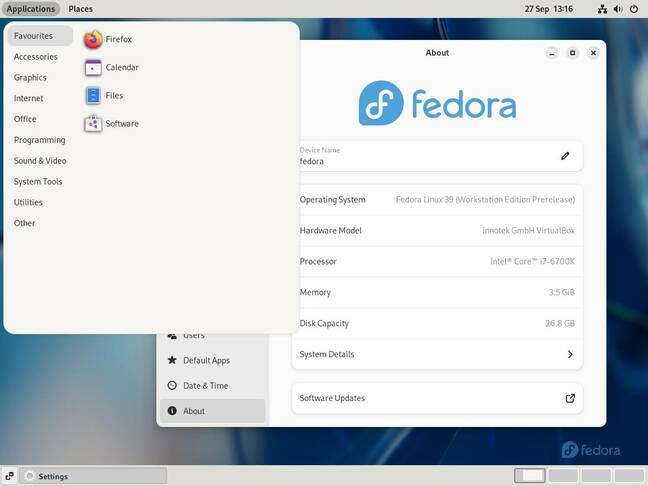
Fedora also offers the GNOME Classic session, which is superficially much more like the good old days of GNOME 2
As we've covered already, you won't be able to customize the desktop very much further yourself because GNOME 45 has changed its extensions system and no old ones will work until updated. We're sure this will follow soon enough – but we're concerned that some of our former favorites, such as extensions to break out GNOME's all-in-one quick settings menu into separate controls, or to remove the title bar of maximized windows and move their controls into the top panel, may never return.
We tried both in VMs, and both installed successfully after some glitches and stumbles. As Fedora's beta has been out longer, there are a lot of available updates – over 1,000 – whereas Ubuntu has just a dozen or so at the time of writing, and feels a little closer to completion.
Changes in this version of Ubuntu
As we previously covered earlier this month, Mantic changes the default installation type to what used to be called a "minimal" installation, which includes Firefox and some essential GNOME accessories – the terminal emulator, text editor, and so on – and little else. The classic Ubuntu installation is still an option, it's just called an "Expanded" install now.
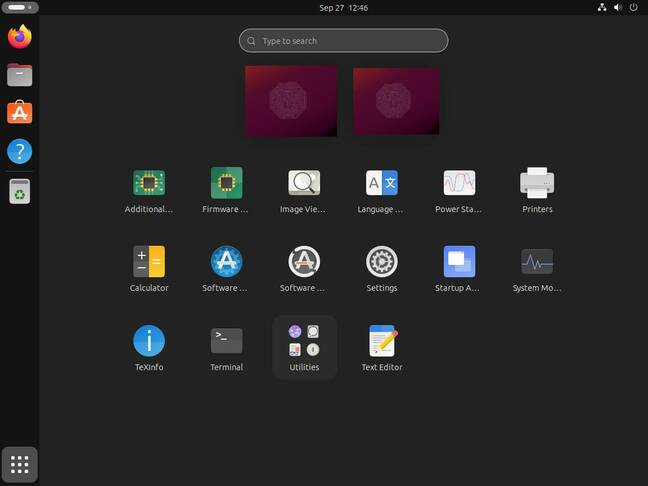
There's less to see in Mantic's applications browser, but we do prefer the vertical dock in the age of widescreens everywhere
Under the hood, there are some deeper changes like better handling of optional repositories, which Canonical calls a "PPA" or Personal Package Archive.
- Linux interop is maturing fast… thanks to a games console
- Rusty revenant Servo returns to render once more
- Long-term support for Linux kernels is about to get a lot shorter
- GNU turns 40: Stallman's baby still not ready for prime time, but hey, there's cake
The Internet Systems Consortium has decreed that its ISC DHCP client has reached EOL, and Ubuntu 23.10 is switching to dhcpd5 instead. To be fair, The Reg has been reporting on problems with ISC DHCP for a very long time.
Those opting for an expanded installation will get version 2 of the GIMP image editor as the changes in GIMP 3 are a bit too radical. For now, the CUPS print subsystem's traditional .deb packaged version remains as its Snap-packaged replacement isn't quite ready yet.
Changes in this version of Fedora
Similarly, a few of the Fedora Project's planned changes haven't made it into this release. Although this vulture attended his first talk about the new and improved DNF5 package manager back in February, it's not yet ready for prime time. The new installation program we looked at earlier this month hasn't made the cut either. Compared to that early build, though, the beta did install successfully in VirtualBox with only cosmetic wobbles.
Clean installations will get a larger ESP, which is useful. They are significantly difficult to enlarge post-install, as this hack has discovered previously. There's a new tool for generating and updating the vital initrd. There's also a fancy colored bash prompt, although this still lags far behind the Powerline prompt used in Linux Lite.
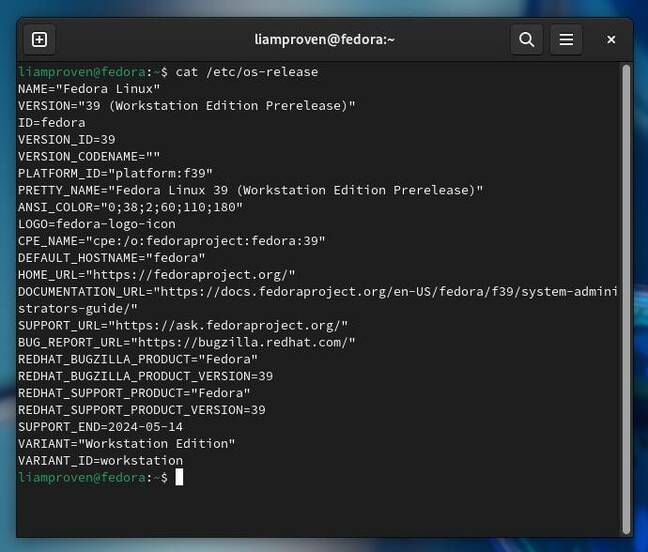
The Bash prompt gets a touch of color in this release, but alternative prompts go much further
An arguably retrograde step is the removal of theming for Qt apps. We'd prefer to see more unified theming, such as the return of Bluecurve, the radical cross-desktop theme last seen in Red Hat Linux 9 – you can see a screenshow in this 20-year-old review. It eludes us why, in this age of ubiquitous branding, the big distros don't impose unified themes across all the desktops they offer.
As you might expect from a developer-focused distro, the latest LLVM 17 is included, as is Go 1.21, and the GNU toolchain has been updated, with GCC 13.2, binutils 2.40, glibc 2.38, and gdb 13.2. The project's wiki has a full ChangeSet.
Try before you commit
Both betas are available now, including in various desktop spins and flavors. The Fedora Magazine announcement summarizes the changes and includes download links.
The Ubuntu Mantic downloads page has the main desktop and server editions. For the various remixes and flavors, the Ubuntu Fridge blog has download links. ®
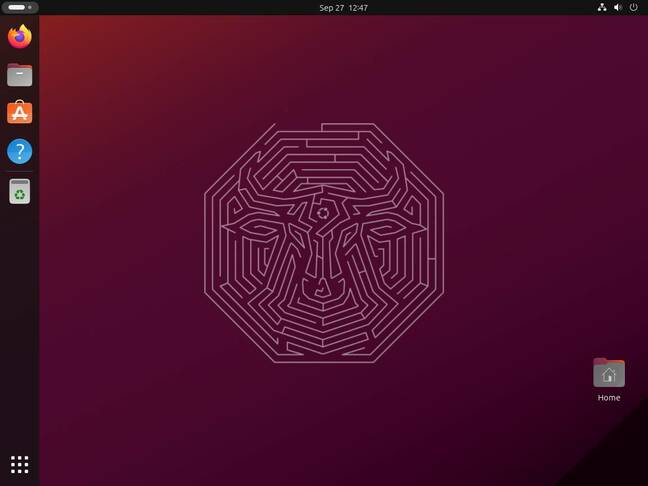
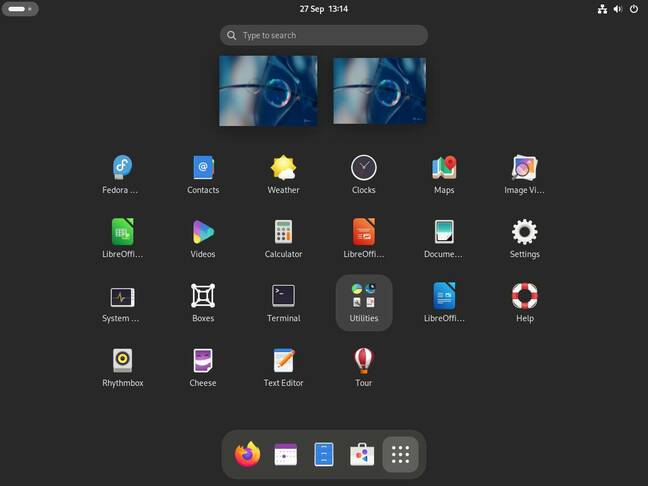
 Biting the hand that feeds IT
Biting the hand that feeds IT